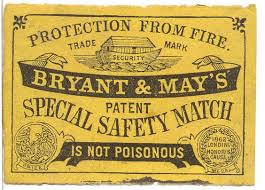One of the most important tools throughout history has been fire. If we go back to the prehistoric times, fire was everything for people. It gave them warmth, light, and cooked their food. The only problem was that it was very difficult for them to create. Most of use can’t imagine what life would have been like without being able to spark a flame easily. Before matches were created, people simply used flint and steel. Thankfully, the match was first created – accidentally- in 1826. In 1826, a pharmacist named John Walker saw a dry lump on a stick when he was working and mixing chemicals. Once he tried to scrape it off, he created a flame. He then created the modern match out of cardboard sticks. He dipped the cardboard into his match head material and – poof – instant matches. These hand made matches started to sell very quickly and once they got more popular, he added wooden splints to his product line. And a touch of sulfur on the tips of the matches, for some added fuel and sensitivity.
The demand for matches grew more and more, and soon factories were created. This invention really took off. Two Quaker merchants named Francis May and William Bryant created a factory in England around 1843 where they made the lucifer match. The end of the match was created from white phosphorous, which is highly toxic. The factory workers suffered the most because of this – a condition called Phossy Jaw. It was a painful and disfiguring condition caused by the toxic chemical. Working to create these matches was extremely dangerous and many of the the working women died. These awful conditions led to the Great Match Strike of 1888, where all of the women walked out of the Bryant & May match factory. For more information on other match factories, read Prelude to the American Match Industry Story.

The Great Match Strike led to safer chemicals used in matches. In 1862, red phosphorus was used to replace the white phosphorus, which could only be lit by striking the side of the match box. The first true Safety Matches. While this was an amazing new invention, people wanted to continue to strike a match anywhere possible. This could only be done by using white phosphorus and for 50 more years, white phosphorus was used despite all of its health risks. By 1910, the manufacturing of lucifer matches had come to an end and the stable red phosphorus is used today. Through all of these engineering changes in the 1800’s, eventually the match came out right. Red phosphorus is printed on the match box, and the match head lights the paper match or wooden stick.
This simple invention is easy to overlook. But he impact it had on world cultures is not. From the employment of thousands of workers to the lighting of indoor gas stoves for kitchen cooking, matches left their mark. In a big way.
The same general design principle of the first safety match creation in 1826 is still used today. Since the 1800’s it has been easy to safely light a match wherever and whenever needed. While there has not been any new engineering on the modern match, it is interesting to know its history. If you want to read more about the market for matches today, read The American Match Industry – Part 1.
Some have tried to improve on the basic invention of the paper matchbook. In the 1970’s the US Consumer Product Safety Commission (CPSC) targeting the industry for safety reforms. The result? Moving the matchbook striker from the front to the back of the book. The consensus at the time was that no additional engineering was possible given the simple basic design of the book match.
Over the decades of the rise of the American Match Factories (until their decline in 1977) each match chemist developed their own proprietary match head formula. Top secret. Still, the basic chemical ingredients were the very same used by Bryant & May. When it comes to building fire, there are only so many options. Mother nature teaches us that.
Eliza Smith is a guest blogger and a student intern. She is studying Business at the College of Charleston in South Carolina. She loves the beach at Sullivan’s Island, and was inspired to write this blog about the impact of plastic on the oceans and the willingness to make a better choice for the environment.

